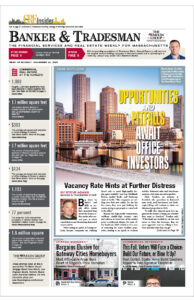The median single-family sale price in Greater Boston hit another high last month even as the number of homes for sale on the market grew. But that record wasn’t $1 million, despite headlines to the contrary.
Instead, it was $850,000 for the 139 towns and cities located within Interstate 495, according to The Warren Group, publisher of Banker & Tradesman, a 2.1 percent increase year-over-year.
The company reported 2,437 single-family sales in June for that area, a 2.8 percent increase.
And the 1,439 condominiums that sold in the area last month did so at a median price of $660,000, marking a 6.5 percent increase and a 3 percent decrease year-over-year, respectively.
As Banker & Tradesman reported earlier this month, the region’s condo sales market was hit particularly badly by concerns about a tariff-driven recession this spring and the future federal research and higher education funding. A higher-than-usual number of sellers brought homes to market this spring, in what observers said was an effort to beat any potential price slide, while more buyers than normal stayed away thanks to concern about their future incomes.
So, why wasn’t the June Greater Boston median single-family sale price $1 million, as some news outlets claimed last week? It all comes down to your definition of “Greater Boston.”
Those news reports cited a Greater Boston Association of Realtors report, which covers the trade group’s territory. But that territory only covers a portion of the Boston area that’s slanted towards both the wealthy MetroWest suburbs and the region’s urban core.
In particular, the trade group’s territory doesn’t include South Shore communities starting with Quincy, Braintree and Holbrook and points east including all of Plymouth County, whose 271 June single-family sales traded at a median price of $651,000.
Similarly, the trade group’s borders mean that $1 million statistic doesn’t include Essex County – June median single-family sale price $775,000 across 389 sales – and it doesn’t go further north along the I-495 corridor than Concord, Acton and Boxboro.
In short, The Warren Group’s data covers a larger area, including some of the remaining relatively affordable communities in Eastern Massachusetts like Lawrence and Plymouth, meaning the median sale price the company reported will be lower.
But no matter what part of the market you look at, market conditions remained tight last month. Middlesex and Suffolk counties had modest upticks in their numbers of singly-families for sale, and Essex, Middlesex and Norfolk counties saw more substantial increases in condominium inventory.
But for the five counties that make up the Boston area’s greatest extent, overall single-family inventory held nearly static at 3,692 listings for sale, while condo inventory grew 7.1 percent to 3,215 listings according to data from the Massachusetts Association of Realtors.
“People tuned into local real estate have seen inventory rise in some markets with an increase in number of active inventory and increased number of days on market per listing,” GBAR 2025 President Mark Triglione said in a statement. “This has led some buyers to believe they may see some relief on prices, but the data and buying behavior continues to defy that notion. List to sales price ratio is still over 100% and properties priced right are selling faster than the recent Red Sox turn around.”
Triglione, owner of the Premier Realty Group brokerage in Reading, speculated that the fall could see a few extra homeowners hoping to move their property before a new state law takes effect banning sellers from making buyers waive their right to a home inspection.
“For most sellers, their home is their largest asset and losing the ability to accept an offer that creates the absolute best possible situation for them to capitalize on could impact the upcoming market,” he said.







